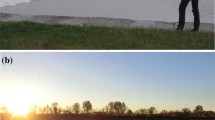Abstract
A tidal bore is a natural and fragile phenomenon, which is of great importance for the ecology of an estuary. The bore development is closely linked with the tidal range and the river mouth shape, and its existence is sensitive to any small change in boundary conditions. Despite their ecological and cultural value, little is known on the flow field, turbulent mixing and sediment motion beneath tidal bores. Indeed, some striking features can be highlighted in two-dimensional simulations, such as large velocity fluctuations and flow recirculation structures. Using Large Eddy Simulation method, the numerical results emphasised the complicated turbulent structures and their unsteadiness under a tidal bore.
Similar content being viewed by others
References
Chan RKC, Street RL (1970) A computer study of finite amplitude water waves. J Comput Phys 6: 68–94
Chanson H (2005) Physical modelling of the flow field in an undular tidal bore. J Hydraul Res 43: 234–244
Chanson H (2008) Turbulence in positive surges and tidal bores—effects of bed roughness and adverse bed slopes. Technical report no. CH68/08. Department of Civil Engineering, The University of Queensland, Brisbane, Australia
Chanson H (2009) Current knowledge in hydraulic jumps and related phenomena. A survey of experimental results. Eur J Mech B 28(2): 191–210
Chanson H (2009) The rumble sound generated by a tidal bore event in the baie du mont saint michel. J Acoust Soc Am 125(6): 3561–3568
Donnelly C, Chanson H (2005) Environmental impact of undular tidal bores in tropical rivers. Environ Fluid Mech 5: 481–494
Falgout RD, Jones JE, Yang UM (2006) The design and implementation of hypre, a library of parallel high performance preconditioners, Chap 51. In: Bruaset AM, Tveito A (eds) Numerical solution of partial differential equations on parallel computers. Springer-Verlag, New York, pp 267–294
Furuyama SI, Chanson H (2008) A numerical study of open channel flow hydrodynamics and turbulence of the tidal bore and dam-break flows. Technical report no. CH66/08. Division of Civil Engineering, The University of Queensland, Brisbane, Australia
Goda K (1978) A multistep technique with implicit difference schemes for calculating two- or three-dimensional cavity flows. J Comput Phys 30: 76–95
Helluy P, Gollay F, Grilli ST, Seguin N, Lubin P, Caltagirone JP, Vincent S, Drevard D, Marcer R (2005) Numerical simulations of wave breaking. Math Model Numer Anal 39(3): 591–608
Jarrin N, Benhamadouche S, Laurence D, Prosser R (2006) A synthetic-eddy-method for generating inflow conditions for large-eddy simulations. Int J Heat Fluid Flow 27: 585–593
Kataoka I (1986) Local instant formulation of two-phase flow. Int J Multiph Flow 12(5): 745–758
Koch C, Chanson H (2005) An experimental study of tidal bores and positive surges: hydrodynamics and turbulence of the bore front. Technical report no. CH56/05. Department of Civil Engineering, The University of Queensland, Brisbane, Australia
Koch C, Chanson H (2008) Turbulent mixing beneath an undular bore front. J Coast Res 24: 999–1007
Koch C, Chanson H (2009) Turbulence measurements in positive surges and bores. J Hydraul Res 47(1): 29–40
LeVeque RJ (1992) Numerical methods for conservation laws. Lectures in mathematics. Birkhauser, Zurich
Lubin P (2004) Large eddy simulation of plunging breaking waves. PhD thesis, Université Bordeaux I (in English)
Lubin P, Lemonnier H (2004) Propagation of solitary waves in constant depths over horizontal beds. Multiph Sci Technol 16(1–3): 237–248
Lubin P, Vincent S, Caltagirone JP (2005) On the navier-stokes equations simulation of the head-on collision between two surface solitary waves. C R Mécanique 333(4): 351–357
Lubin P, Vincent S, Abadie S, Caltagirone JP (2006) Three-dimensional large eddy simulation of air entrainment under plunging breaking waves. Coast Eng 53: 631–655
Maxworthy T (1976) Experiments on collisions between solitary waves. J Fluid Mech 76: 177–185
Patankar SV (1990) Numerical heat transfer and fluid flow. Hemisphere Publishing Corporation, New York
Rudman M (1998) A volume-tracking method for incompressible multifluid flows with large density variations. Int J Numer Meth Fluids 28(2): 357–378
Sagaut P (1998) Large Eddy Simulation for incompressible flows—an introduction. Springer Verlag, Berlin
Sagaut P, Grohens R (1999) Discrete filters for large eddy simulation. Int J Numer Meth Fluids 31: 1195–1220
Simpson JH, Fisher NR, Wiles P (2004) Reynolds stress and tke production in an estuary with a tidal bore. Estuar Coast Shelf Sci 60: 619–627
Su CH, Mirie RM (1980) On head-on collision between two solitary waves. J Fluid Mech 98: 509–525
Tessier B, Terwindt JHJ (1994) An example of soft sediment deformations in an intertidal environment: the effect of a tidal bore. Comptes Rendus—Academie des Sciences, Serie II 319: 217–223
Wolanski E, Moore K, Spagnol S, D’Adamo N, Pattiaratchi C (2001) Rapid, human-induced siltation of the macro-tidal ord river estuary, western australia. Estuar Coast Shelf Sci 53: 717–732
Wolanski E, Williams D, Spagnol S, Chanson H (2004) Undular tidal bore dynamics in the daly estuary, northern australia. Estuar Coast Shelf Sci 60: 629–636
Wolanski E, Williams D, Hanert E (2006) The sediment trapping efficiency of the macro-tidal daly estuary, tropical australia. Estuar Coast Shelf Sci 69: 291–298
Author information
Authors and Affiliations
Corresponding author
Electronic Supplementary Material
The Below is the Electronic Supplementary Material.
Rights and permissions
About this article
Cite this article
Lubin, P., Chanson, H. & Glockner, S. Large Eddy Simulation of turbulence generated by a weak breaking tidal bore. Environ Fluid Mech 10, 587–602 (2010). https://doi.org/10.1007/s10652-009-9165-0
Received:
Accepted:
Published:
Issue Date:
DOI: https://doi.org/10.1007/s10652-009-9165-0




